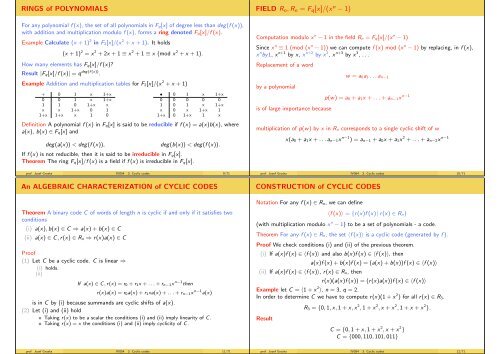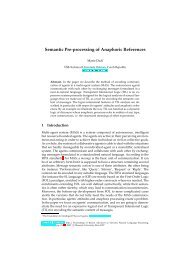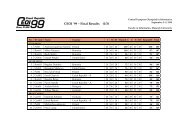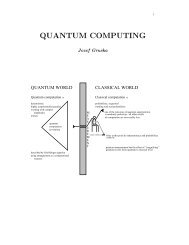2×2 handouts
2×2 handouts
2×2 handouts
You also want an ePaper? Increase the reach of your titles
YUMPU automatically turns print PDFs into web optimized ePapers that Google loves.
RINGS of POLYNOMIALS<br />
For any polynomial f (x), the set of all polynomials in F q [x] of degree less than deg(f (x)),<br />
with addition and multiplication modulo f (x), forms a ring denoted F q [x]/f (x).<br />
Example Calculate (x + 1) 2 in F 2 [x]/(x 2 + x + 1). It holds<br />
(x + 1) 2 = x 2 + 2x + 1 ≡ x 2 + 1 ≡ x (mod x 2 + x + 1).<br />
How many elements has F q [x]/f (x)?<br />
Result |F q [x]/f (x)| = q deg(f (x)) .<br />
Example Addition and multiplication tables for F 2 [x]/(x 2 + x + 1)<br />
+ 0 1 x 1+x<br />
0 0 1 x 1+x<br />
1 1 0 1+x x<br />
x x 1+x 0 1<br />
1+x 1+x x 1 0<br />
• 0 1 x 1+x<br />
0 0 0 0 0<br />
1 0 1 x 1+x<br />
x 0 x 1+x 1<br />
1+x 0 1+x 1 x<br />
Definition A polynomial f (x) in F q [x] is said to be reducible if f (x) = a(x)b(x), where<br />
a(x), b(x) ∈ F q [x] and<br />
deg(a(x)) < deg(f (x)),<br />
deg(b(x)) < deg(f (x)).<br />
If f (x) is not reducible, then it is said to be irreducible in F q [x].<br />
Theorem The ring F q [x]/f (x) is a field if f (x) is irreducible in F q [x].<br />
FIELD R n , R n = F q [x]/(x n − 1)<br />
Computation modulo x n − 1 in the field R n = F q [x]/(x n − 1)<br />
Since x n ≡ 1 (mod (x n − 1)) we can compute f (x) mod (x n − 1) by replacing, in f (x),<br />
x n by1, x n+1 by x, x n+2 by x 2 , x n+3 by x 3 , . . .<br />
Replacement of a word<br />
by a polynomial<br />
is of large importance because<br />
w = a 0 a 1 . . . a n−1<br />
p(w) = a 0 + a 1 x + . . . + a n−1 x n−1<br />
multiplication of p(w) by x in R n corresponds to a single cyclic shift of w<br />
x(a 0 + a 1 x + . . . a n−1 x n−1 ) = a n−1 + a 0 x + a 1 x 2 + . . . + a n−2 x n−1<br />
prof. Jozef Gruska IV054 3. Cyclic codes 9/71<br />
An ALGEBRAIC CHARACTERIZATION of CYCLIC CODES<br />
Theorem A binary code C of words of length n is cyclic if and only if it satisfies two<br />
conditions<br />
(i) a(x), b(x) ∈ C ⇒ a(x) + b(x) ∈ C<br />
(ii) a(x) ∈ C, r(x) ∈ R n ⇒ r(x)a(x) ∈ C<br />
Proof<br />
(1) Let C be a cyclic code. C is linear ⇒<br />
(i) holds.<br />
(ii)<br />
If a(x) ∈ C, r(x) = r 0 + r 1 x + . . . + r n−1 x n−1 then<br />
r(x)a(x) = r 0 a(x) + r 1 xa(x) + . . . + r n−1 x n−1 a(x)<br />
is in C by (i) because summands are cyclic shifts of a(x).<br />
(2) Let (i) and (ii) hold<br />
Taking r(x) to be a scalar the conditions (i) and (ii) imply linearity of C.<br />
Taking r(x) = x the conditions (i) and (ii) imply cyclicity of C.<br />
prof. Jozef Gruska IV054 3. Cyclic codes 10/71<br />
CONSTRUCTION of CYCLIC CODES<br />
Notation For any f (x) ∈ R n , we can define<br />
〈f (x)〉 = {r(x)f (x) | r(x) ∈ R n }<br />
(with multiplication modulo x n − 1) to be a set of polynomials - a code.<br />
Theorem For any f (x) ∈ R n , the set 〈f (x)〉 is a cyclic code (generated by f ).<br />
Proof We check conditions (i) and (ii) of the previous theorem.<br />
(i) If a(x)f (x) ∈ 〈f (x)〉 and also b(x)f (x) ∈ 〈f (x)〉, then<br />
(ii) If a(x)f (x) ∈ 〈f (x)〉, r(x) ∈ R n , then<br />
a(x)f (x) + b(x)f (x) = (a(x) + b(x))f (x) ∈ 〈f (x)〉<br />
r(x)(a(x)f (x)) = (r(x)a(x))f (x) ∈ 〈f (x)〉<br />
Example let C = 〈1 + x 2 〉, n = 3, q = 2.<br />
In order to determine C we have to compute r(x)(1 + x 2 ) for all r(x) ∈ R 3 .<br />
Result<br />
R 3 = {0, 1, x, 1 + x, x 2 , 1 + x 2 , x + x 2 , 1 + x + x 2 }.<br />
C = {0, 1 + x, 1 + x 2 , x + x 2 }<br />
C = {000, 110, 101, 011}<br />
prof. Jozef Gruska IV054 3. Cyclic codes 11/71<br />
prof. Jozef Gruska IV054 3. Cyclic codes 12/71















